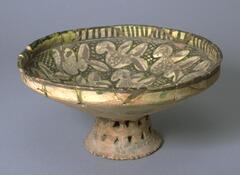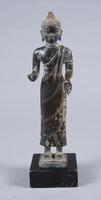13 UMMA Objects
13 UMMA Objects
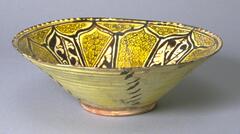
Iranian (Iranian)
Shallow bowl with stylized floral medallion
1000 – 1199
Museum purchase made possible by the Margaret Watson Parker Art Collection Fund
1961/1.183
![<p>This type of bowl was extensively produced throughout the 12th century. The outer wall is decorated with incised and raised deisgn of a two-tiered lotus petal. The glaze was oxidized, producing yellow-green color, but the application of glaze to the entire foot and the use of quartzite spurs indicate that this was produced as a high-quality item.<br />
[<em>Korean Collection, University of Michigan Museum of Art</em> (2014) p.103]</p>
It has a wall gently curving from the mouth toward the bottom before angeling in sharply close to the foot. There is a lotus petal on exterior. The color is brown. <p>This type of bowl was extensively produced throughout the 12th century. The outer wall is decorated with incised and raised deisgn of a two-tiered lotus petal. The glaze was oxidized, producing yellow-green color, but the application of glaze to the entire foot and the use of quartzite spurs indicate that this was produced as a high-quality item.<br />
[<em>Korean Collection, University of Michigan Museum of Art</em> (2014) p.103]</p>
It has a wall gently curving from the mouth toward the bottom before angeling in sharply close to the foot. There is a lotus petal on exterior. The color is brown.](/media/W1siZiIsIjIwMjIvMDUvMjUvMTBnN25oa2prcF9kZWZhdWx0LmpwZyJdLFsicCIsInRodW1iIiwiMjQweDIwMCJdXQ?sha=225012457d334d64)
Korean (Korean (culture or style))
Bowl with carved lotus pattern
12th century
Transfer from the College of Architecture and Design
1972/2.78

Chinese (Chinese (culture or style))
Bowl
1000 – 1132
Gift of Mrs. Caroline I. Plumer for the James Marshall Plumer Collection
1973/2.14
![<p>This bowl has a narrow foot and a ared mouth. is type of bowl was produced in large quantities from the 11th century to the 12th century. Its inner wall has mold-impressed peony sprays. The entire body of the bowl is glazed, including the inside of the foot, but the glaze on its rim of the foot was wiped away, on which refractory spurs were adhered to for ring. Parts of the inner surface show ne crackles, while the inner bottom was stained with greenish-brown iron spots. One part of the rim was damaged and subsequently repaired. Glaze applied to the outer surface has partially owed downwards, resulting in an uneven surface, but the glaze and clay are quite well fused and sintered.<br />
[<em>Korean Collection, University of Michigan Museum of Art</em> (2014) p.93]</p>
<br />
The celadon bowl has straight-lined sides. The surface is evenly coated with a dark bluish green glaze. The celadon bowl rests on a rather tall foot, which was hollowed out from the bottom. The designs are present only on the inside <p>This bowl has a narrow foot and a ared mouth. is type of bowl was produced in large quantities from the 11th century to the 12th century. Its inner wall has mold-impressed peony sprays. The entire body of the bowl is glazed, including the inside of the foot, but the glaze on its rim of the foot was wiped away, on which refractory spurs were adhered to for ring. Parts of the inner surface show ne crackles, while the inner bottom was stained with greenish-brown iron spots. One part of the rim was damaged and subsequently repaired. Glaze applied to the outer surface has partially owed downwards, resulting in an uneven surface, but the glaze and clay are quite well fused and sintered.<br />
[<em>Korean Collection, University of Michigan Museum of Art</em> (2014) p.93]</p>
<br />
The celadon bowl has straight-lined sides. The surface is evenly coated with a dark bluish green glaze. The celadon bowl rests on a rather tall foot, which was hollowed out from the bottom. The designs are present only on the inside](/media/W1siZiIsIjIwMjIvMDkvMjQvOWpqdXU4d2plel9kZWZhdWx0LmpwZyJdLFsicCIsInRodW1iIiwiMjQweDIwMCJdXQ?sha=d6b4e1202cb44ca4)
Korean (Korean (culture or style))
Conical bowl with molded floral design
12th century
Gift of Bruce and Inta Hasenkamp and Museum purchase made possible by Elder and Mrs. Sang-Yong Nam
2004/1.222
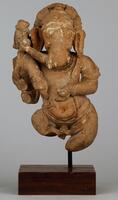
Indian (Indian (South Asian))
Dancing Ganesha
1000 – 1199
Gift of Mark Phillips and Iuliana Phillips
2007/2.45
![<p>The inner surface of this bowl features an incised design of two parrots with long tails resembling phoenixes. e entire body of the bowl was glazed including the rim of the foot, on which remain three quartzite spur marks. Although some fireclay has fallen inside the kiln during ring and adhered to the inner surface of the bowl, the state of sintering is good. The piece as a whole is a high-quality ware with a glossy surface and a fine color of glaze. The base of the foot is cracked which occurred while drying before the application of glaze.<br />
[<em>Korean Collection, University of Michigan Museum of Art </em>(2014) p.94]</p>
high quality, incised, double-parrot motif shallow bowl, nice shallow fully glazed foot, three spur marks, firing discoloration, kiln trash fall on glaze, 11th century. <p>The inner surface of this bowl features an incised design of two parrots with long tails resembling phoenixes. e entire body of the bowl was glazed including the rim of the foot, on which remain three quartzite spur marks. Although some fireclay has fallen inside the kiln during ring and adhered to the inner surface of the bowl, the state of sintering is good. The piece as a whole is a high-quality ware with a glossy surface and a fine color of glaze. The base of the foot is cracked which occurred while drying before the application of glaze.<br />
[<em>Korean Collection, University of Michigan Museum of Art </em>(2014) p.94]</p>
high quality, incised, double-parrot motif shallow bowl, nice shallow fully glazed foot, three spur marks, firing discoloration, kiln trash fall on glaze, 11th century.](/media/W1siZiIsIjIwMjIvMDkvMjQvNWdrcXY3YnBzbV9kZWZhdWx0LmpwZyJdLFsicCIsInRodW1iIiwiMjQweDIwMCJdXQ?sha=3c44f3270b71b87f)
Korean (Korean (culture or style))
Bowl with incised pattern of paired phoenixes
1067 – 1132
Gift of Bruce and Inta Hasenkamp and Museum purchase made possible by Elder and Mrs. Sang-Yong Nam
2004/1.215

Chinese (Chinese (culture or style))
Covered Five-tube Jar
1000 – 1199
Museum purchase made possible by Mrs. Caroline I. Plumer and the Friends of the Museum
1987/2.46A&B
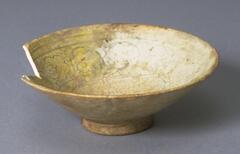
Syrian
Shallow bowl with incised floral designs (chip missing)
1000 – 1199
Transfer from the College of Architecture and Design
1972/2.138
![<p>A circle is incised on the wide inner base of this bowl; the base is decorated with a chrysanthemum floret and is surrounded by lotus scrolls on the wall. There is a crack on the inner base which formed during firing, but the overall state of sintering is fine. There are six refractory spur marks on the foot. Part of the mouth had been broken off and restored.<br />
[<em>Korean Collection, University of Michigan Museum of Art </em>(2014) p.95]</p>
The celadon bowl is close in shape to a perfect hemisphere, and its rim is turned very slightly outward. There is a peony design on the wall and bottom. The color is olive grey. It has a small concave foot. <p>A circle is incised on the wide inner base of this bowl; the base is decorated with a chrysanthemum floret and is surrounded by lotus scrolls on the wall. There is a crack on the inner base which formed during firing, but the overall state of sintering is fine. There are six refractory spur marks on the foot. Part of the mouth had been broken off and restored.<br />
[<em>Korean Collection, University of Michigan Museum of Art </em>(2014) p.95]</p>
The celadon bowl is close in shape to a perfect hemisphere, and its rim is turned very slightly outward. There is a peony design on the wall and bottom. The color is olive grey. It has a small concave foot.](/media/W1siZiIsIjIwMjIvMDkvMjQvNXl3NXZucWgyZl9kZWZhdWx0LmpwZyJdLFsicCIsInRodW1iIiwiMjQweDIwMCJdXQ?sha=252796f0a02b862c)
Korean (Korean (culture or style))
Bowl with incised floral pattern on interior bottom and sides
1050 – 1150
Gift of Bruce and Inta Hasenkamp and Museum purchase made possible by Elder and Mrs. Sang-Yong Nam
2004/1.224
Loading…

